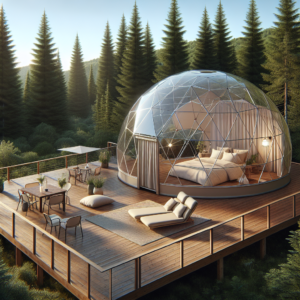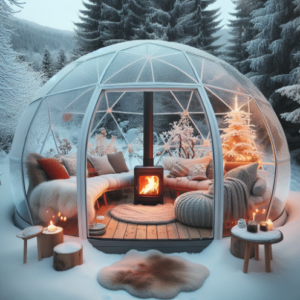
Key Takeaways
-
Geodesic dome homes are incredibly strong and energy-efficient due to their unique shape.
-
They can withstand extreme weather conditions better than traditional homes.
-
Despite their advantages, dome homes are not mainstream due to challenges in construction, design, and public perception.
-
Adopting a geodesic dome home can significantly reduce your carbon footprint.
-
Understanding the benefits and overcoming the hurdles can lead to more sustainable living.
When we talk about homes, we usually imagine four walls, a bunch of windows, and a rectangular door. But what if I told you that there’s a type of home that not only looks like it’s from the future but also helps you live more sustainably? I’m talking about geodesic dome homes, the spherical wonders that have been intriguing eco-enthusiasts for decades.
Transforming the Landscape: The Potential Future of Dome Homes

Now, you might wonder why, with all their benefits, geodesic dome homes aren’t lining every street in our neighborhoods. It’s a fair question, and the answer lies in a blend of unfamiliarity, aesthetic preference, and the inertia of traditional construction methods. But before we dive into why they aren’t mainstream, let’s explore what makes them such a marvel in the first place.
From Niche to Mainstream: A Roadmap for Adoption
First things first, we’ve got to acknowledge the elephant in the room: change is hard. Transitioning from conventional homes to domes is like switching from a flip phone to a smartphone—it takes a bit of learning and adjustment. Most importantly, it requires a change in mindset. To bring geodesic dome homes into the mainstream, we need to spread awareness about their benefits and demonstrate how they can seamlessly integrate into our lives.
Education is key. People need to know that these domes can save money on energy bills, reduce environmental impact, and even offer a unique aesthetic appeal. Besides that, we need builders who are willing to learn new construction techniques and cities that are open to updating zoning laws to accommodate these futuristic abodes.
The Role of Technology in Advancing Dome Home Popularity
Technology has a significant role to play here. With the advent of 3D modeling and virtual reality, potential homeowners can now take a virtual tour of a geodesic dome home before it’s even built. This experience can demystify the dome and show just how cozy and functional they can be.
Moreover, advances in building materials and techniques are making dome construction simpler and more cost-effective. This, combined with growing environmental concerns, is slowly pushing geodesic dome homes towards a tipping point where they could become the new normal.
But for that to happen, we need early adopters and trendsetters. Those brave souls who are willing to take the leap and show the world that living in a dome isn’t just practical, it’s also a statement of sustainability.
Uncovering the Mystery: What Makes Geodesic Dome Homes Unique?
Geodesic dome homes are not just unique in appearance; their design is a testament to human ingenuity and our ability to live in harmony with nature. These homes are based on geodesic polyhedra, which means they are made up of triangles that distribute structural stress evenly. This design makes them incredibly robust and able to withstand forces that would level traditional homes.
Defining the Geodesic Dome Home
So what exactly is a geodesic dome home? Imagine a sphere made up of dozens, sometimes hundreds, of small triangles. This is the essence of a geodesic dome. It’s a structure that covers a lot of space without internal supports, like columns or load-bearing walls. This design not only makes them strong but also frees up interior space for a more open and airy living environment.
Because of their shape, geodesic domes have a lower surface area relative to their volume compared to rectangular homes. This means less external surface for heat to escape or enter, which translates to better insulation and more efficient temperature regulation. And who wouldn’t want a home that stays cool in the summer and warm in the winter without breaking the bank?
-
They are made up of interconnected triangles that create a spherical shape.
-
Their design allows for even distribution of stress, making them strong and durable.
-
They offer a spacious interior without the need for internal supports.
Now, let’s get a little bit of history into the mix. The architectural genius behind the geodesic dome was Buckminster Fuller, a man who believed that technology and design could save the world. He saw the potential for dome homes to provide affordable, efficient housing. And he was right—their energy efficiency and use of materials make them an excellent choice for sustainable living.
The Architectural Vision of Buckminster Fuller
Buckminster Fuller wasn’t just an architect; he was a visionary. He patented the geodesic dome in the mid-20th century, believing it could revolutionize the way we live. Fuller’s domes were designed to be cost-effective and easy to assemble, with the goal of providing housing solutions that could be quickly deployed around the world.
His dream was for these domes to be the homes of the future, and while they haven’t taken over the world just yet, they’ve certainly left their mark. Fuller’s legacy lives on in the domes that dot the landscape, from eco-villages to disaster relief shelters, and yes, even private residences.
The Appeal of Geodesic Homes: A Blend of Innovation and Sustainability

When we talk about innovation in architecture, geodesic dome homes are a prime example. They embody a blend of design ingenuity and a deep commitment to sustainability. The benefits of these homes extend beyond their visual appeal; they are a testament to what happens when we align our living spaces with the principles of eco-friendliness and energy conservation.
The Geometric Powerhouse: Strength and Efficiency
The triangle, the strongest shape in geometry, is the building block of geodesic domes. This gives them a natural advantage in terms of structural integrity. But the benefits don’t stop there. The dome’s shape encloses the most living space with the least amount of surface area, leading to a reduction in the materials needed for construction. This means fewer resources are consumed, and the environmental impact of building a home is lessened.
Moreover, the aerodynamic shape of the dome allows it to withstand high winds and heavy snow loads, making it an ideal choice for areas prone to extreme weather. These homes don’t just stand up to the elements; they shrug them off with ease.
How Dome Homes Promote Green Living
Living green isn’t just about recycling or driving less; it’s also about how we choose to build our homes. Geodesic dome homes are inherently more energy-efficient due to their ability to circulate air and heat naturally. Their design minimizes cold spots and requires less energy for heating and cooling, which is a significant step towards reducing our carbon footprint.
Breaking the Mold: The Advantages of Dome-Shaped Living
Choosing a geodesic dome home is a statement. It says that you’re willing to break the mold and embrace a living space that offers a unique combination of benefits. From their ability to inspire awe to their functional advantages, dome homes are a bold departure from the norm.
Weathering the Storm: Disaster-Resilient Features
One of the most compelling reasons to consider a geodesic dome home is its resilience. Their spherical design evenly distributes any external pressure across the entire structure, making them incredibly stable during earthquakes, hurricanes, and tornadoes. It’s no wonder they’re often used in disaster-prone areas where traditional homes would struggle to stand.
Keeping the Balance: Thermal Dynamics and Energy Savings
The dome shape isn’t just for show; it plays a crucial role in maintaining a comfortable climate inside the home. The curvature of the dome allows for efficient air flow and even temperature distribution. This means you spend less on heating and cooling, which not only saves money but also reduces energy consumption. It’s a win-win for both your wallet and the planet.
The Road Less Traveled: Challenges Faced by Geodesic Homes

Despite their many benefits, geodesic dome homes face challenges that have kept them from becoming mainstream. Understanding these challenges is key to appreciating why these eco-friendly options are still relatively rare in the housing market.
Aesthetic Uniqueness and Societal Perception
The unconventional look of geodesic dome homes can be a double-edged sword. While some see them as modern and innovative, others find them too radical or out of place. This difference in aesthetic preference has a significant impact on their popularity. Moreover, because they are not the norm, they can face resistance from zoning boards, homeowners’ associations, and even potential buyers who are more comfortable with traditional home designs.
Practical Constraints in Construction and Design
Building a geodesic dome home isn’t the same as putting up a standard house. Specialized knowledge is required, both in terms of construction and interior design. The curved walls can pose challenges for fitting furniture and installing conventional utilities. These practical constraints, although not insurmountable, contribute to the hesitation some people feel about adopting dome homes.
Geodesic Dome Homes: Cost, Savings, and Eco-Friendly Living
Assessing Costs, Savings, and ROI
The initial cost of a geodesic dome home can vary widely depending on size, location, materials, and labor. However, you can expect to spend anywhere from $120 to $150 per square foot for a basic dome kit. Customization and high-end finishes will add to that cost. But here’s where it gets interesting: the energy savings over time can be substantial. With their superior insulation and reduced need for heating and cooling, you could see your utility bills drop by 30% or more. That’s a return on investment that keeps giving back, year after year.
Now, let’s consider the long-term benefits. A geodesic dome’s durability means less maintenance and fewer repairs. Combine that with the potential for lower insurance premiums due to their disaster-resistant nature, and you’re looking at significant savings. Plus, if you’re one to think about resale value, the unique appeal of a dome home can be a selling point for the right buyer.
Making the Eco-Friendly Choice: Is It Right for You?
Deciding to live in a geodesic dome home is more than just an economic decision; it’s a lifestyle choice. If you’re someone who prioritizes environmental stewardship, values resilience, and doesn’t mind standing out from the crowd, then a dome might just be your dream home. But remember, it’s not just about being different—it’s about making a difference. By choosing a geodesic dome, you’re reducing your carbon footprint and living in a way that’s more in tune with our planet’s future.
Frequently Asked Questions
Let’s address some of the most common questions about geodesic dome homes to help clarify any lingering doubts or curiosities you might have.
What Are the Key Benefits of Living in a Geodesic Dome Home?
The benefits of living in a geodesic dome home are numerous, but let’s focus on the highlights:
-
Strength and Durability: The dome’s structure is one of the most stable, able to withstand high winds, earthquakes, and heavy snow loads.
-
Energy Efficiency: The shape and design of domes allow for natural temperature regulation, leading to lower energy costs.
-
Eco-Friendly: Reduced material requirements and the potential for integrating renewable energy sources make domes an environmentally conscious choice.
-
Spacious Interiors: The lack of load-bearing walls inside a dome means more open living spaces and creative freedom in design.
-
Unique Aesthetic: For those who value individuality, the distinctive look of a dome home is sure to stand out.
How Do Geodesic Dome Homes Contribute to Energy Efficiency?
Geodesic dome homes are a paragon of energy efficiency for several reasons. Their spherical shape minimizes surface area, reducing heat loss in the winter and heat gain in the summer. The natural air flow within a dome prevents hot and cold spots, meaning your HVAC system doesn’t have to work as hard. Additionally, the potential for skylights and strategically placed windows maximizes natural light, cutting down on the need for artificial lighting.
What Materials Are Used in Constructing a Geodesic Dome Home?
Construction of a geodesic dome home typically involves a framework of wooden struts or steel beams that form the geometric pattern of the dome. This framework is then covered with a variety of materials, including:
-
Traditional insulation and sheathing
-
Weatherproof membranes or sealants
-
Exterior cladding, which can range from wood to metal to composite materials
-
Interior finishes similar to those found in conventional homes
Some dome homes also incorporate sustainable materials like recycled wood, eco-friendly insulation, or green roofing systems to further reduce their environmental impact.
How Do Geodesic Dome Homes Withstand Extreme Weather?
The geodesic dome’s shape distributes any external pressure evenly across the entire structure, allowing it to withstand extreme weather conditions better than traditional homes. Their aerodynamic form deflects high winds, and the triangular components provide exceptional strength for bearing heavy loads, such as snow or debris. This resilience is one of the reasons why dome homes are often found in regions prone to natural disasters.
What Are the Main Hurdles to Building a Geodesic Dome Home?
While geodesic dome homes have many advantages, they also come with their own set of challenges:
-
Building Codes: Local building codes may not be accustomed to dome structures, leading to potential hurdles in the permitting process.
-
Construction Expertise: Builders familiar with dome construction are less common, which can make finding the right contractor more difficult.
-
Interior Design: The curved walls of a dome can pose challenges for arranging furniture and installing cabinetry.
-
Market Perception: Because they are unconventional, dome homes can be a harder sell in the real estate market, potentially affecting resale value.
Despite these hurdles, the growing interest in sustainable living and advancements in construction technology are making it easier to overcome these obstacles. As more people become aware of the benefits of dome homes, we can expect to see them become a more common sight in our communities.




